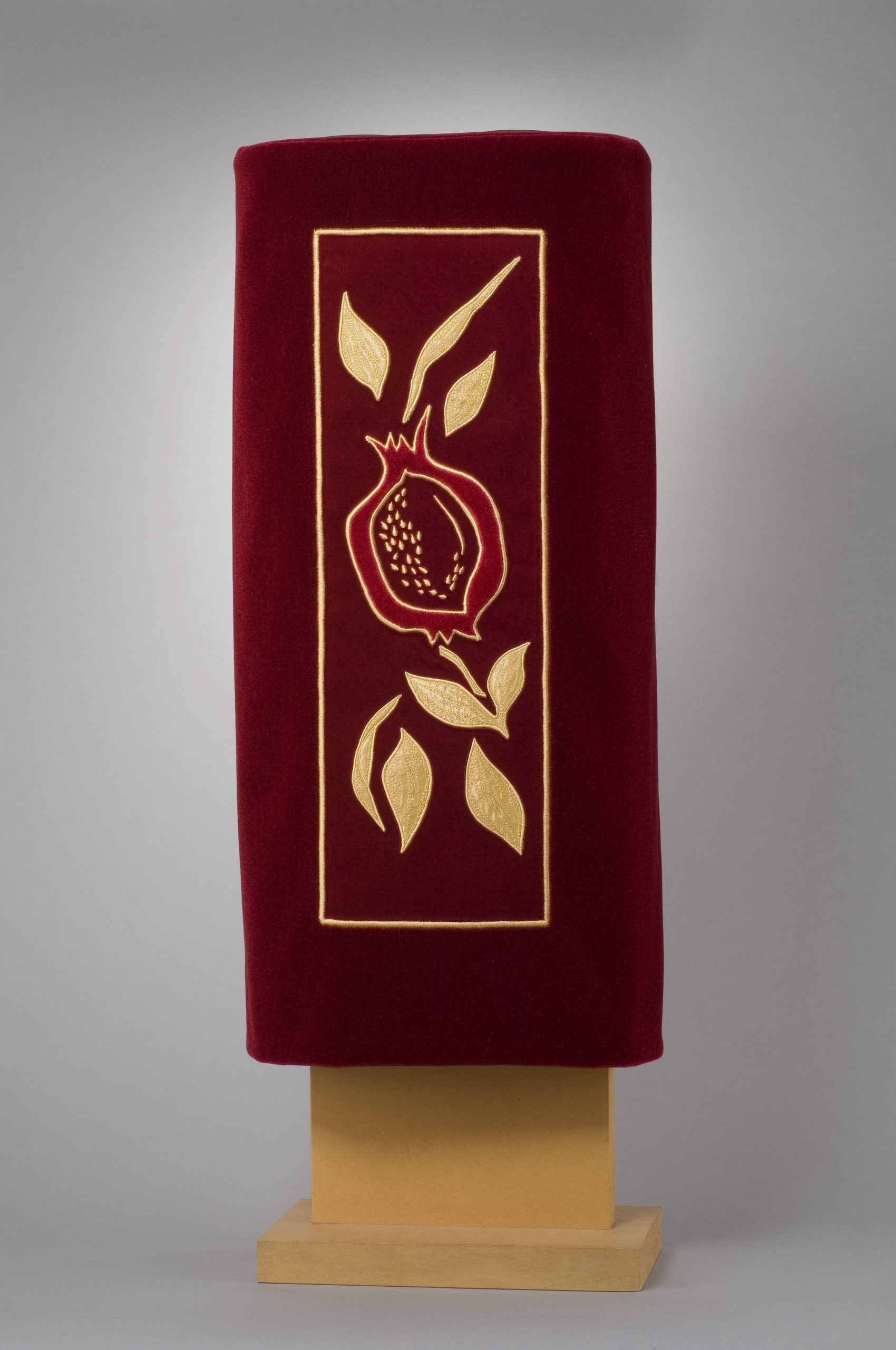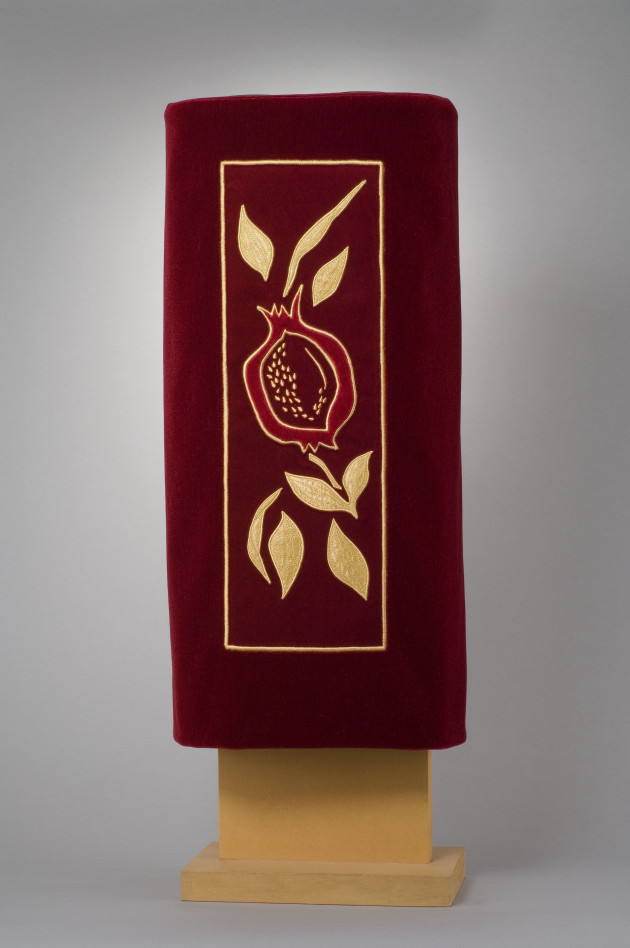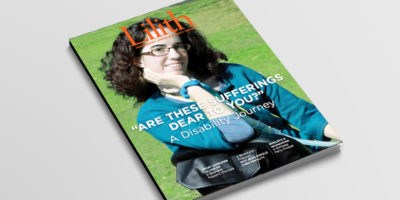
Dressing [and Undressing] the Torah
Called up to the synagogue bimah to put the cover back on the Torah, she receives — unanticipated — her flash of illumination.

Pomegranate Torah Cover. Temple Beth Sholom, Miami Beach, FL. Laurie Gross Studios © 2007.
I rarely frequent synagogues. Even with my father’s yahrzeit, I disliked being lost in the too-fast romp through prayers that left me continually searching for a familiar word once gleaned in Hebrew School. The experience is more treasure hunt than homage or call to remembrance, and it ends in frustration and embarrassment. My husband usually accompanies me when I go to shul and is able to point to what page, what line, what psalm is being chanted, in the blur of flying pages, by someone who usually sings rather nasally.
Yesterday was the final day of saying kaddish for my mother, and I expected to be in and out. Typically, my sister, the shul-goer, gave me the wrong information, and so I ended up coming at the wrong time and sitting totally alone — which was fine — while she sat surrounded by all her family, including the 3-month-old grandchild. There are a number of kaddishes said throughout the service, and though I know that they’re all not mourners’ kaddishes, to me they are almost identical.
So as the first (false) mourners’ kaddish came flying at me, I felt myself overwhelmed in sadness and the tears began leaping from my eyes. I hadn’t expected this rush of emotion, as my mother had been gone for a year, and the unveiling was behind us. It seemed the stage was set for one more upheaval of kishka-deep feelings.
The usher appeared in the aisle and asked if members of my sister’s family would participate in the service. They agreed, and then the usher poked me, asking if I would like to “dress” the Torah. I say “poked” because one of my hearing aids is being replaced next week so at present I am only hearing in the right ear.
I nervously agreed and then tiptoed to my sister’s pew and whispered that I had no idea what to do. She said she didn’t either, because roles like these being given to women in our synagogue are rather recent.
So the day, for me, was already emotional, but I figured this is an honor I must not forego, and, really, how hard could it be to dress a Torah?
No one told me when I should go up to the bimah, so I had to keep pestering my brother-in-law: there was no way I would understand the barrage of words announcing individual attendants all intertwined with Torah protocol. I might have been able to make out my Hebrew name — Pesah — but, then again, no one had asked for it. My brother-in-law explained that I should just follow his son-in-law who would be holding the Torah when I dressed it. So I waited. And when Joe rose, so did I.
I mounted the bimah and was about to sit down when the rabbi gestured, No, that Joe would sit. Okay. Someone brought the Torah over and indicated that there was a soft band attached with Velcro that had to be wrapped around the Torah’s body. It was a soft color, like the color of a doe, and it had to be stretched a little to fit around the scrolls.
Next there was the “dress” — with beautiful, red roses appliquéed on a light-blue and gray-blue background. Slowly and lovingly, I eased it over the wooden handles that furl and unfurl the endless parchment of hand-written words. I realized almost immediately that I had put it on backwards. Uh-oh. Would the next reader have a surprise on opening it, and not be able to read the portion that went with the particular day? Would I have to fast for 365 days? — for if you drop the Torah, I somehow believe that is the punishment. What was the rule for contravening the Torah’s dress code?
Someone in a hushed tone noted that, Yes indeed, the outer dress of the Torah had been reversed. So I carefully inserted my hands beneath the appliquéed roses, taking meticulous care not to touch the parchment or any sacred words, trying to lift the covering in much the same way that I might ease a well-worn cotton undershirt over the head of a small child afraid of the dark. Smoothly. Softly. Taking my time. Murmuring words of love and encouragement.
I didn’t want to touch or frighten the people who lived in the words of the text — baby Moses, grownup Moses, Sarah — I didn’t want to jar them. I wanted to offer my affection, my connection to them, my forefathers and foremothers, to their stories and tribulations, to the words that scribes had managed to record that kept traveling through millennia even unto this moment. Suddenly, I was outside of time, way beyond time, fused with something so much bigger.
I had been given a tremendous honor, and dressing the Torah backwards had extended the moment, lengthening it for me alone, clasping me into a perhaps world that I had almost always failed to fathom.
Many years ago when my son started Sunday School, he told us he was afraid of going back. Why, we queried. He said the teacher had told the class that the following week they would draw back the curtains of the Holy Ark to see the bones of our ancestors and he didn’t want to see any bones. We laughed and said, Not bones, you silly. BOOKS.
And now here for me were the Bones and the Books. I felt the love of a mother as I tenderly dressed the Torah, something I had done over and over again, with love, for my children and grandchildren, and even for my own mother. It recalled an out-of-time moment I experienced once doing art — calm, disconnected with my earthly family — time that lost me and made me grieve returning to the literal.
So, yesterday. Yesterday was a big surprise. I was given the unexpected gift of dressing and undressing and redressing a Torah. What happened, I don’t know. But for a moment I was a mystic and a rabbi and a mother and my mother, and I am grateful and inexplicably altered.
Patricia F. Goldblatt developed the standards and ethics for the Ontario College of Teachers and the College of Early Childhood Educators. The author of scholarly articles, she is also the editor of two books based on teachers’ narratives. Visit her at bloggingboomer.wordpress.com.


